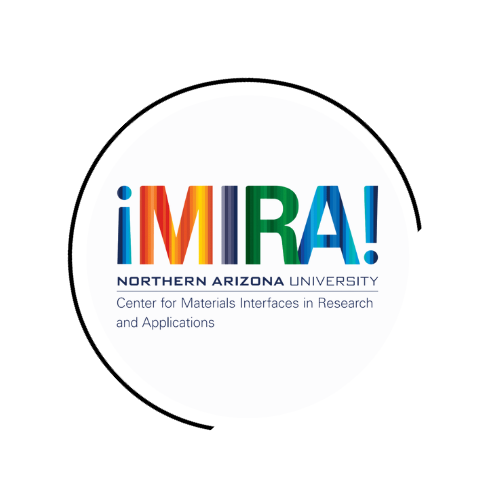
Gabriel A. Montaño
Professor
Applied Physics and Materials Science
Director
Center for Materials Interfaces
in Research and Applications
Contact information
Phone: (928) 523-2353
Email: Gabriel.montano@nau.edu
Office: Bldg 36, Room 327
About
Our research focus is biophysical materials chemistry.
We work at the interface of physical and biological sciences in the realm of materials science. We utilize biophysical tools and bio/synthetic architectures toward two main goals: 1) understanding complex processes of living systems through investigation of model assemblies, and; 2) understanding bio-synthetic interfaces toward integrating biological design into materials development.
Ongoing Lab Project:
Bio-inspired supramolecular membrane materials: Typically, supramolecular biological membrane systems exist in non-equilibrium states necessary to perform their complex biological functions. A focus of our research team in this area is mimicking such non-equilibrium design and functionality in (bio)synthetic materials design. Our designs are typically based upon amphiphilic block-copolymer supramolecular assemblies capable of dynamic, non-equilibrium organization and bio-like functionality.
Learn more about Dr. Montaño’s research:
- Google Scholar
- NSF awarded grant (September 2024)- Materials Interfaces Research and Access-(MIRA-PREM)- an NSF PREM Center
Biography
Representative References:
1. Orf, G., Collins, A., Niedzwiedzki, D., Tank, M., Thiel, V., Adam, K., Bryant, D., Blankenship, R.E., Montaño, G.A. (2017) Polymer-chlorosome nanocomposites consisting of non-native combinations of self-assembling bacteriochlorophylls. Langmuir, 33(25), pp 6427-6438.
2. Collins, A.M., Timlin, J.A., Anthony, S.M. & Montaño, G.A. (2016) Chlorosome nanocomposite mimics using a short-chain emphiphilic polymer as the membrane-organizing matrix. Nanoscale, 8, 15056-63.
3. Adams, P.G., Collins, A.M., Sahin, T., Subramanian, V., Urban, V.S., Vairaprakash, P., Tian, Y., Evans, D.G., Shreve, A.P., & Montaño, G.A. (2015) Diblock copolymer micelles and supported films with noncovalently incorporated chromophores: a modular platform for efficient energy transfer. Nano letters 15(4): 2422-2428.
4. Goertz, M.P., Marks, L.E. & Montaño, G.A. (2012) Biomimetic Monolayer and Bilayer Membranes Made From Amphiphilic Block Copolymer Micelles. ACS Nano: 6(2):1532-40.
Biological Membrane Dynamics:
Supported lipid membranes provide a useful platform for interrogating biological membrane interactions and interfaces. A focus of our research team in this area is the investigation of biological membrane processes using supported lipid membranes as a platform for interrogation. It is possible using such platforms to understand complex membrane activities in a controlled environment.
Representative References:
1. Stromberg, L.R., Hengartner, N.W., Swingle, K.L., Moxley, R.A., Graves, S.W., Montaño, G.A.,Mukundan, H.(2016) Membrane insertion for the detection of lipopolysaccharides: Exploring the dynamics of amphiphile-in-lipid assays. PLoS ONE, 11(5).
2. Adams, P.G., Swingle, K.L., Paxton, W.F., Firestone, M.A., Mukundan, H., & Montaño, G.A. Exploiting lipopolysaccharide-induced deformation of lipid bilayers to modify membrane composition and generate two-dimensional geometric membrane array patterns. Sci. Report 5, 10331.
3. Lamoreux, L., Adams, P., Banisadr., A., Stromberg, Z., Graves, S., Montaño, G., Moxley, R., & Mukundan, H. (2015) An optical biosensor for detection of pathogen biomarkers from Shiga toxin-producing Escherichia coli in ground beef samples. Proc. Of SPIE 9310: 931004-1.
4. Adams, P.G., Lamoureux, L., Swingle, K.L., Mukundan, H. & Montaño, G.A. (2014) Lipopolysaccharide induced dynamic lipid organizations: lipid tubules, membrane perforations and multi-lamellar stacking. Biophys J. 106(11): 2395-407.
Scanning Probe Force Applications Development:
Scanning probe microscopies have proven an effective means of interrogating dynamic interactions. Our research focus in this area is in developing platforms that allow for interrogating dynamic materials interactions at the biological and bio-synthetic interfaces.
Representative References:
1. Brambilla, S., Speckart, S., Rush, M.N., Montaño, G.A., Brown, M.J. (2018) Glass particle resuspension from a contaminated (dirty) glass surface. J. or Aerosol Science 123, pp 122-130.
2. Rush, M.N., Brambilla, S., Speckart, S., Montaño, G.A., Brown, M.J. (2018) Glass-particle adhesion-force-distribution on clean (laboratory) and contaminated (outdoor) surfaces. J. of Aerosol Science 123, pp 231-244.
Professional Experience
Chief Scientist and Founder of ¡MIRA! Center for Materials Interfaces in Research and Applications, Northern Arizona University (2019-current)
Professor and Chair, Department of Applied Physics and Materials Science, Northern Arizona University (2019-current)
University Chief Diversity Fellow, Northern Arizona University (2019-current)
Center for Integrated Nanotechnologies- Affiliate Scientist
Professor, Department of Chemistry and Biochemistry, Northern Arizona University (2018)
Scientist IV, MPA-CINT, Los Alamos National Laboratory. (2005-2018)
Awards and Honors
William Yslas Velez outstanding STEM award (2018)
Distinguished Affiliate Scientist- Center for Integrated Nanotechnologies (CINT)- (2017-2019)
Appointed to the Council of Senior Advisors (COSA) of SACNAS
President, President-Elect and Past-President SACNAS Board of Directors (2014-2017)
Elected to SACNAS Board of Directors (2011-2014)
SACNAS Presidential Award-2006
Intelligence Community Postdoctoral Fellowship-2002-2005

